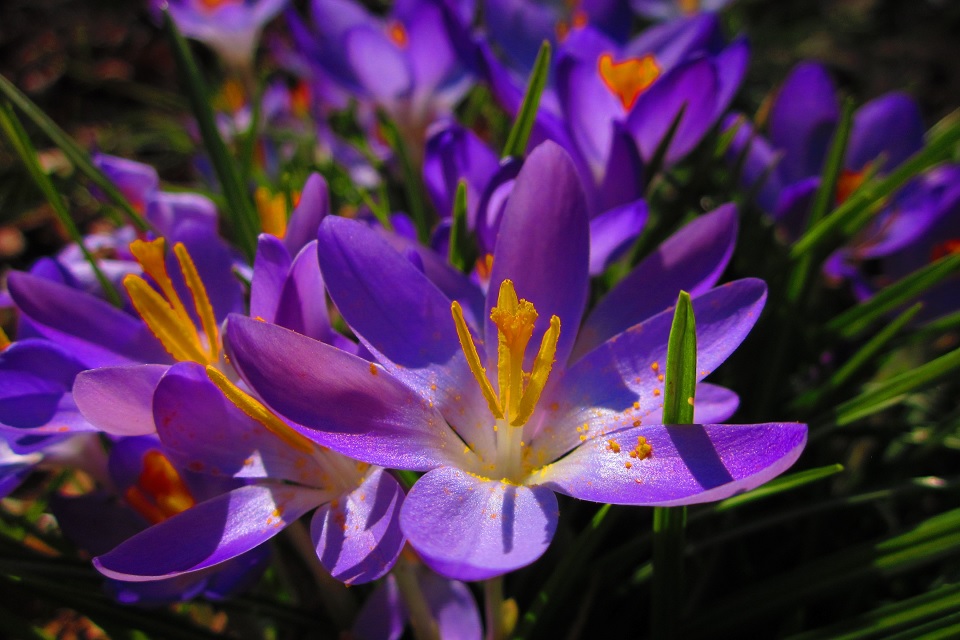
A Pretty Harbinger of Spring
From the UT Gardens
February 2016 Plant of the Month: Crocus
Submitted by Amanda Plante, an alumna of the University of Tennessee Gardens internship program
Nothing says “spring is coming” like a flower, and few early bloomers announce it as colorfully as Crocus. Small but vibrant, Crocus species appear after Galanthus nivalis (common snowdrop) finish their winter show in January or early February. Crocus blossoms range from ghostly white to golden yellow to deep purple, with some variegated options. The petals fold closed on dark evenings and cloudy days, making the blooms resemble a thin balloon. When the sun is out, the petals unfurl to form a beautiful, almost star- shaped flower with striking golden pollen-covered stamen in the center.
Native to Southern Europe, one distinguishing feature of this genus is that they grow from corms. A corm is a swollen modified stem that stores food, energy and water for the plant. Crocus corms are unique in that they have contractile roots, which reach out and contract to pull themselves to their ideal depth or even right themselves if accidentally placed upside-down in the hole.
Many garden centers and nurseries are sure to stock the very popular Dutch crocus (C. vernus), and other species are available by special request or ordering from catalogs. Look for varieties with different bloom periods to extend flowering in the landscape. While this month is a good time to see the flowers in bloom, Crocus should be planted when temperatures are below 60 degrees but before the first freeze, typically between October and November. Plant about 3 inches deep and 4 inches apart.
Crocus are attractive in the front of a garden bed and can be planted among bulbs and perennials that bloom later in the season. Corms can also be safely planted around the base of trees, although for best blooming consider planting with deciduous trees that allow dappled sunlight.
Squirrels, chipmunks, voles and mice are Dutch crocus’ enemy in the landscape. If these critters are a persistent problem in your garden, test a small patch of Crocus before investing in big drifts. C. tommasinianus is the only species Dr. Steven Still notes as “squirrel resistant” in his Manual of Herbaceous Ornamental Plants (1994, Stripes Publishing L.L.C.), but note that this species is a prolific spreader. It’s great for naturalized drifts, but can be difficult to control in the garden.
A growing trend has been to inter-plant Crocus with turfgrass. Showy blooms will carpet the lawn weeks before grass needs to be mowed, and Crocus’ strappy green foliage will blend in with the turf after flowering is finished. Although C. vernus has been used in lawns with limited success, the best species for reliable, perennial blooms in the lawn is C. tommasinianus.
In addition to Crocus’ merit as a beautiful and cheerful winter bloomer, one species, C. sativus, is the source of the spice saffron. Henry Beston describes C. sativus in Herbs and the Earth (1935, D.R. Godine, Publisher, Inc.): “An autumn Crocus with a long history as a drug, a flavoring powder, and a pigment, only the golden stigma of the flower being used… May not overwinter.” True enough, although many Crocus are perennial in Tennessee, as a USDA Hardiness Zone 8 plant C. sativus may not overwinter for many Tennesseans. If that doesn’t deter you from growing your own saffron, Steven Still writes that “about 7000 flowers are required to produce 3 ounces of saffron.”
The UT Gardens, Jackson, features crocus among its collections.
The UT Gardens includes plant collections located in Knoxville, Jackson and Crossville. Designated as the official botanical garden for the State of Tennessee, the collections are part of the UT Institute of Agriculture. The gardens’ mission is to foster appreciation, education and stewardship of plants through garden displays, educational programs and research trials. The gardens are open during all seasons and free to the public. For more information see the Gardens website: utgardens.tennessee.edu.
Contact:
Amanda Plante through Susan Hamilton, director of the UT Gardens, UT Department of Plant Sciences